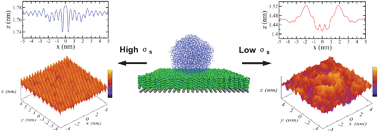Hydrophobic-induced surface reorganization: molecular dynamics simulations of water nanodroplets on perfluorocarbon self-assembled monolayers
Abstract
We carried out molecular dynamics simulations of

* Corresponding authors
a
Department of Biomedical Engineering and Chemistry of Life Processes Institute, Northwestern University, 2145 Sheridan Road, Evanston, Illinois, USA
E-mail:
igalsz@northwestern.edu
We carried out molecular dynamics simulations of

 Please wait while we load your content...
Something went wrong. Try again?
Please wait while we load your content...
Something went wrong. Try again?
S. H. Park, M. A. Carignano, R. J. Nap and I. Szleifer, Soft Matter, 2010, 6, 1644 DOI: 10.1039/B923392J
To request permission to reproduce material from this article, please go to the Copyright Clearance Center request page.
If you are an author contributing to an RSC publication, you do not need to request permission provided correct acknowledgement is given.
If you are the author of this article, you do not need to request permission to reproduce figures and diagrams provided correct acknowledgement is given. If you want to reproduce the whole article in a third-party publication (excluding your thesis/dissertation for which permission is not required) please go to the Copyright Clearance Center request page.
Read more about how to correctly acknowledge RSC content.
 Fetching data from CrossRef.
Fetching data from CrossRef.
This may take some time to load.
Loading related content
